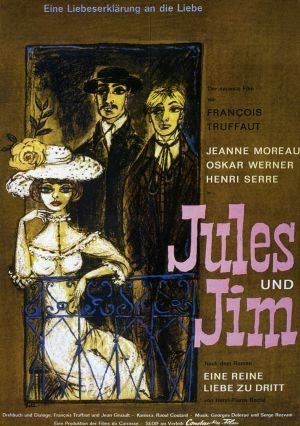Director: Francois
Truffaut
 Jules et Jim is considered one of the best works of the
French New Wave cinema. Giving a great importance to cinematography, the
importance of the camera in films is highlighted. Due to monetary and ideological
reasons, the departure from elaborate sets and costumes is very much evident as
in every other new wave film; real locations and outdoors are of great
importance.
Jules et Jim is considered one of the best works of the
French New Wave cinema. Giving a great importance to cinematography, the
importance of the camera in films is highlighted. Due to monetary and ideological
reasons, the departure from elaborate sets and costumes is very much evident as
in every other new wave film; real locations and outdoors are of great
importance.
Technique:
Jules et Jim employs many innovative techniques in the film
which still now inspire and affect many filmmakers and their styles. With the
use of jump cuts, panning shots and dolly Truffaut makes the narration fast
paced and exhilarating as the story speeds along 25 years of the friendship. He
employs the use of freeze frames which are almost indecipherable and any cinephile
would notice this influence in a Scorsese or a Tarantino film.
Another interesting aspect is the use of archival footage
and snapshots that deliberately move the art of filmmaking away from the
classical Hollywood technique of classified shots and direction. Camera
movement in the film is also very obvious in many scenes where the viewer can
actually make out the camera moving as the frame changes on screen.
Characters:
As the story is set in the time from the beginning of World
War 1 to the rise of Hitler, feminism is a strong motif in the film throughout,
with the character of Catherine defying all traditional “values” of being a
woman with her free spirit and her beliefs. There is a scene in the film where
Jules talks about how a woman is always second to a man and is always a ‘slut’
and Catherine retaliates by jumping into the river before asking Jim to protest
against Jules’ views.
Hers is the most interesting character and the catalyst of
all events. She knows she can control men around her and does that to her
enjoyment. Sometimes she is emotionally drawn to someone while other times
declares herself ‘heartless’. Had she existed today, she would challenged every
woman around her, a dynamic and excitable woman, Catherine with her shades of
grey and a flawed moral judgement still doesn’t let the audience hate her.
Jules on the other hand is the image of an ideal lover, ever
faithful, as a friend and as a husband, he understand the needs of his wife and
his best friend and even the people around him that he is ready to sacrifice
his happiness for them. An adjusting character that finds happiness in every
situation and doesn’t really question much around him.
Jim is a stronger version of Jules who values his friendship
with Jules a lot. He shares his interests with Jules and together they are
formidable partnership which cannot be destroyed by anything or anyone. They
share their thoughts, secrets and lives. Jim is one person who develops the
most in the film, challenging what everyone does and his role in things,
finally changing himself.
The real World and the film:
As the world around them changes, Europe is declining into a
state of war with World War 1 and the rise of Hitler, the film looks at it from
the point of view of the three characters and their relationship which stands
the test of the Great War despite them being from enemy countries.
The lives around them change, people mature, the way of
living is changing following this, their dynamics also change as their
personality adapts to everything around them.
A scene in the film has them discuss how women are now
wearing shorter skirts and cut their hair short much to the disdain of married
soldiers and how French wine is better than German beer. Theirs is a strong influence
of French culture and a foreigner’s view is also employed with Jules being an Austrian
in the film. France is looked upon as an open society with a great stress upon leisure
and how the war and circumstances change that for people who start looking upon
the life seriously and as the rise of Hitler is a tragic turn for the world,
the film also takes a tragic turn in the end.
